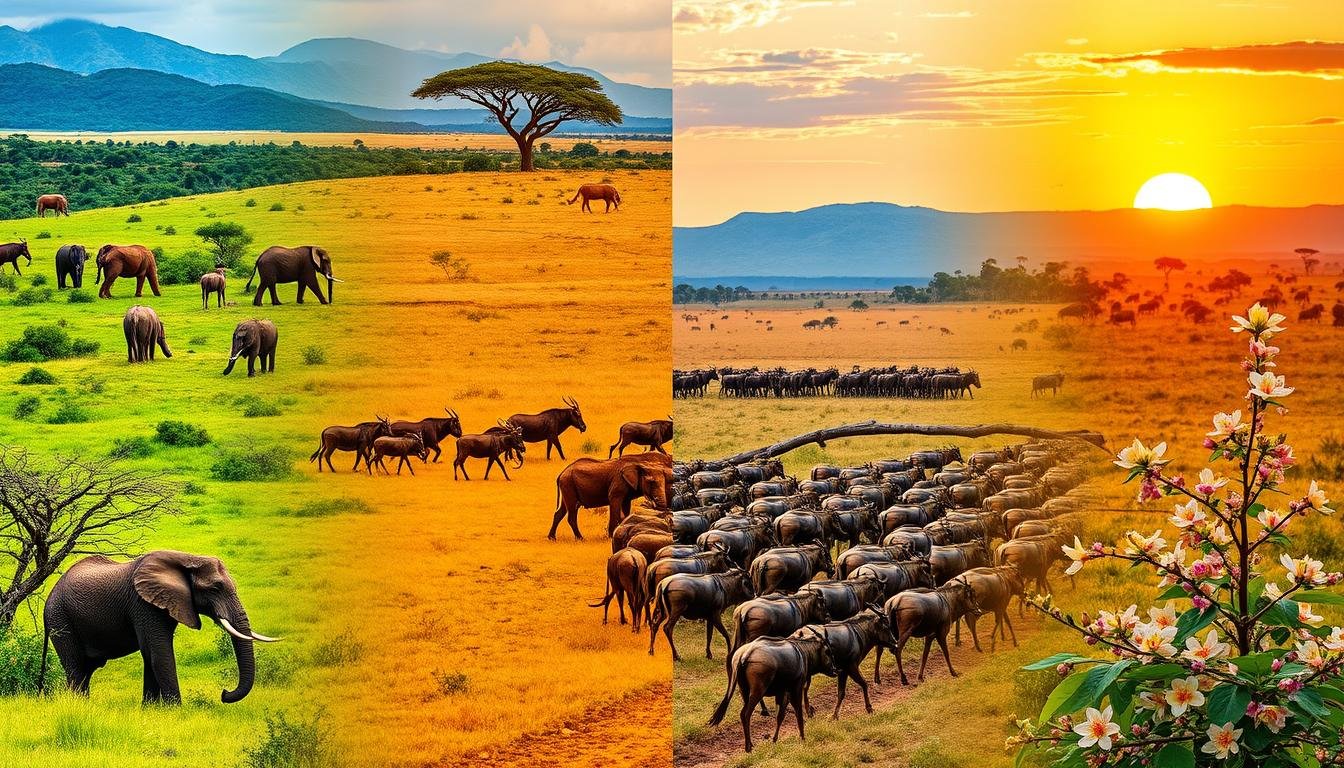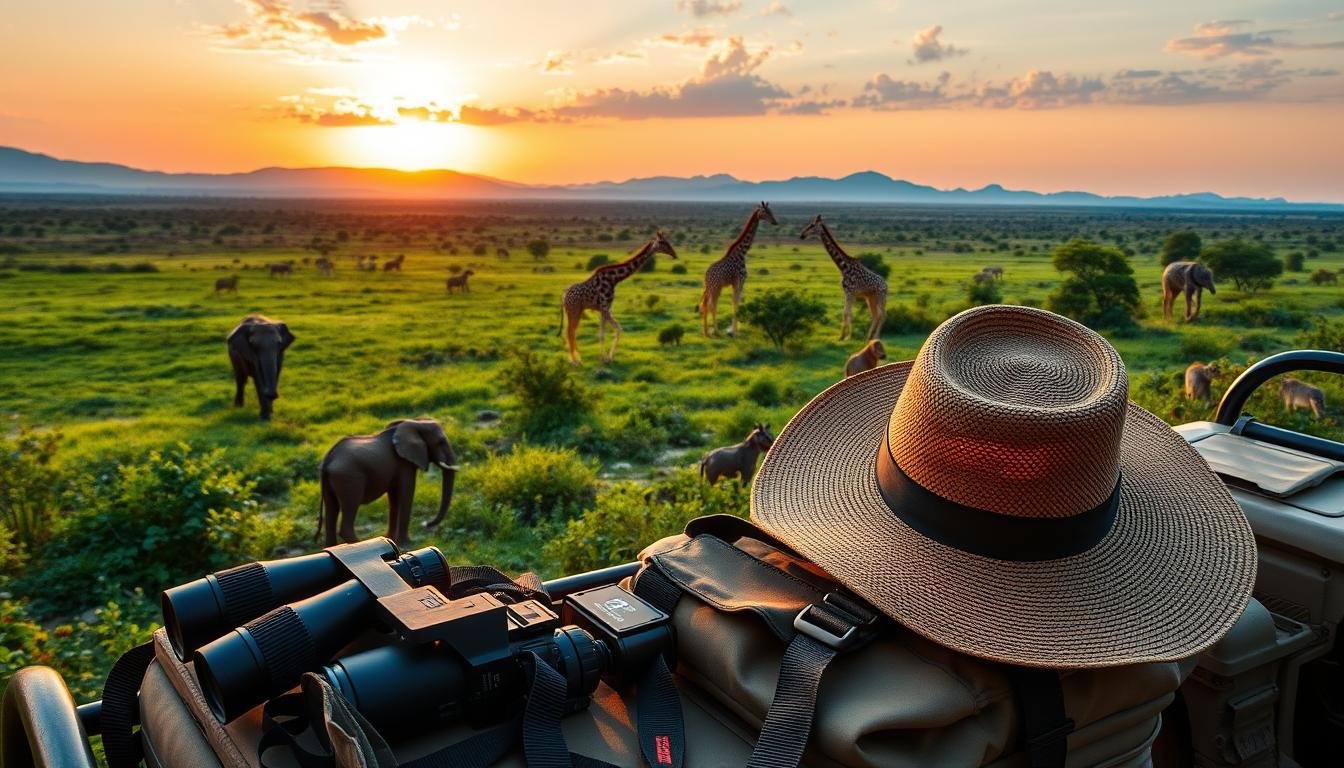Going on a Tanzania safari means you need to pack smart. Bringing the right packing for tanzania safari, safari essentials, and tanzania safari checklist makes your trip comfy and fun. You’ll see Tanzania’s beautiful landscapes, from the coast to the highlands. This guide will give you top tips and a detailed safari packing list for Aussie travellers.
It’s key to pack the right safari travel necessities for a great tanzania safari preparation and safari gear australia. We’ll cover clothes, safari essentials, and tanzania safari checklist. This way, you’ll have a smooth and memorable tanzania safari adventure.
Key Takeaways
- Carefully curate your packing list to ensure comfort and preparedness for Tanzania’s diverse landscapes and climates.
- Invest in lightweight, quick-drying, and breathable clothing in neutral colours to blend in with your surroundings.
- Prioritise sturdy, comfortable footwear with good traction for navigating the rugged terrain during game drives and walks.
- Pack a basic first aid kit, insect repellent, and any necessary medications to safeguard your health during the safari.
- Organise your luggage with soft-sided bags, backpacks, and packing cubes for easy access and organisation.
Why Packing Properly for a Tanzania Safari Matters
Going on a Tanzania safari adventure means you need the right gear for comfort and safety. The country’s varied landscapes, from tropical coasts to cool highlands, require adaptable clothes and gear. This is because the weather changes a lot.
Creating a good Tanzania safari packing list is key to a great experience. The right clothes, shoes, and essentials keep you comfy. They also help you tackle tough terrain and unexpected weather easily.
Adapting to Tanzania’s Diverse Climates
Tanzania has many climates, from the warm coast to the cool highlands. It’s smart to pack versatile, quick-drying clothes that you can layer. This way, you stay comfy as the weather changes.
Being ready for the weather lets you enjoy the stunning views and wildlife. You can dive into the adventure without worrying about the weather.
| Tanzania Climate Zones | Recommended Packing Items |
|---|---|
| Coastal Regions | Lightweight, breathable fabrics; sun protection (hats, sunglasses, sunscreen) |
| Highlands | Warm layers (sweaters, jackets); sturdy, closed-toe footwear |
| Serengeti Plains | Neutral-coloured, long-sleeved clothing; insect repellent |
Knowing Tanzania’s climates and packing right helps you enjoy your safari. You can do game drives, hiking, and explore amazing landscapes without worry.
Good tanzania safari packing means you’re comfy and safe. You can fully enjoy the Tanzanian wilderness. With the right prep, you’ll make unforgettable memories and capture amazing moments.
Essential Clothing Items for a Tanzania Safari
When you go on a Tanzania safari, it’s important to pack the right clothes. This ensures you have a comfortable and fun trip. Tanzania’s varied landscapes and changing weather need careful packing.
Lightweight and Quick-Drying Clothing
Opt for clothes that are light and dry quickly. Tanzania safari clothing in colours like beige, khaki, and olive green work best. They match the natural scenery and keep tsetse flies away.
Layering for Comfort
The temperature can change a lot during the day. It might be cool in the morning and evening but warm in the afternoon. So, layering is key. Pack t-shirts, long-sleeved shirts, and light jackets or sweaters. This lets you change your safari wardrobe to stay comfortable.
Sturdy Footwear
Wear closed-toe shoes or hiking boots with good grip and support. These are vital for walking on rough terrain during game drives and safaris. They keep you safe and stable while you see Tanzania’s beautiful sights.
With the right tanzania safari packing list of clothes and shoes, you’re ready for an amazing Tanzanian safari adventure.
Packing for tanzania safari: The Ultimate Checklist
Getting ready for a Tanzania safari means making a detailed packing list. This list ensures you have everything for a fun and comfy trip. Here’s what you need to pack:
- Travel Documents: Carry your passport, Tanzania visa, and other important travel papers.
- Clothing: Pack light, quick-drying clothes in neutral colors like t-shirts, polo shirts, and long pants. Don’t forget layers for different weather, like a light jacket or sweater.
- Footwear: Choose comfy, closed-toe shoes or hiking boots with good grip and support.
- Rainy Season Gear: If you’re visiting from March to May or October to December, bring a raincoat and rain trousers.
- Cold Weather Essentials: From May to September, pack thermal underwear, gloves, and a warm hat.
- Photography Gear: Bring your camera, lots of memory cards, and a light tripod or monopod.
- Optics: Pack binoculars to see wildlife better.
- Health and Hygiene: Include insect repellent, sunscreen, personal toiletries, and any needed meds, like antimalarials.
- First Aid Kit: Make a basic first aid kit with bandages, antiseptic, and any must-have meds.
- Accessories: Remember a flashlight or headlamp, chargers, and power adapters for UK-style sockets.
- Luggage: Choose soft-sided luggage, like duffel bags or sports bags, as they fit easily in safari vehicles.
- Daypack: Carry a comfy backpack for your day essentials.
- Cash and Security: Spread your cash in different places, like your wallet, money belt, and luggage, for safety.
- Souvenirs: Save some space in your luggage for souvenirs, or send them home via courier.
Packing smart is key for a great Tanzania safari. With this checklist, you’re all set for an amazing adventure!
Choosing the Right Footwear for Tanzania Safari Adventures
When you go on a Tanzania safari, the right shoes are key. You need closed-toe shoes or hiking boots for safety and comfort. They should have good grip and support your ankles.
Factors to Consider When Selecting Safari Footwear
- Duration Impact: For short trips, you might need different shoes. But for long tours, a single pair of safari boots is better.
- Seasonal Variation: In the rainy season, waterproof boots are a must. In dry months, you can wear breathable shoes or sandals.
- Type of Safaris: For hiking safaris, you need hiking shoes for tanzania that are top-notch. For game drives, comfort is more important since you’ll be in vehicles a lot.
- Boot Weight: Lighter boots are easier to walk in. They should also support your arches and be rigid.
- Water Resistance: Keeping your feet dry is important, especially in wet weather to avoid blisters.
- Sole Design: A strong tread and rigid shank help with grip and protect against sharp things.
- Lace Material: Braided nylon cords are more durable than flat laces for your laces.
In Australia, there are many great safari shoes to choose from. The Merrell Moab 2 Ventilator, Salomon X Ultra 3 GTX, and Keen Targhee III are top picks. They’re known for being comfy, durable, and grippy, perfect for your Tanzanian safari.
“Choosing the right footwear is essential for a comfortable and safe safari experience in Tanzania.”
Choosing the right tanzania safari footwear and taking care of it can really make your safari trip a success.
Important Travel Documents for Your Tanzania Safari
Going on a Tanzania safari means you need to prepare well. Getting the right travel documents is key. You’ll need a valid visa and a yellow fever vaccination certificate, among other things.
- Passport: You must have a passport that’s valid for at least six months after you arrive. Always carry the original passport, not a copy.
- Visa: You might need a visa to get into Tanzania. Apply early, as it can take up to three weeks. You can get an e-visa online or at a Tanzanian embassy.
- Yellow Fever Vaccination Certificate: If you’re coming from a yellow fever risk area, you’ll need a vaccination certificate. This is a must for entering Tanzania.
- Travel Insurance Documents: Good travel insurance is a must for your safari. Make sure you have all your policy details and emergency contacts.
- Return Flight or Proof of Onward Travel: Tanzania wants to see your return ticket or travel plans when you arrive.
- Payment Methods: Bring cash (Tanzanian shillings and US dollars), credit cards, and traveller’s cheques for your expenses.
Getting your Tanzania safari documents ready early is vital for a smooth trip. With all your paperwork sorted, you can enjoy the amazing sights, wildlife, and culture of Tanzania.
Travel document needs can change based on your nationality and safari plans. Always check with your travel agent or Tanzanian embassy for the latest info. This way, you’ll be ready for an amazing Tanzania safari adventure.
First Aid and Medication Essentials
Going on a Tanzania safari means you need a good first aid kit and the right medicines. Your kit should have bandages, antiseptic wipes, pain relievers, and meds for upset stomachs.
Don’t forget insect repellent. Mosquitoes and tsetse flies can spread diseases like malaria. Always talk to your doctor about malaria meds before you go, as malaria is a big risk in Tanzania.
Tailoring Your First Aid Kit
While a standard first aid kit is a good start, make it your own. Think about what you really need for your safari. Here are some ideas:
- Plasters (bandages) of various sizes
- Elastic bandages
- Small scissors
- Gauze pads
- Surgical tape
- Tweezers
- Antiseptic wipes
- Pain relief tablets (paracetamol or ibuprofen)
- Loperamide tablets (for temporary diarrhoea relief)
- Antihistamine cream
- Antibacterial creams
Remember to pack any medicines you take and enough for your whole trip. With the right first aid and medicines, you can enjoy Tanzania’s amazing wildlife and views without health worries.

“Proper preparation is the key to a successful and safe Tanzania safari.”
Photography and Optics: Capturing the Moments
Capturing the incredible tanzania safari photography and stunning landscapes of Tanzania during your safari adventure requires the right equipment. A good quality camera, preferably with interchangeable lenses, will allow you to immortalise the memorable moments. A zoom lens of at least 200mm is recommended to bring the distant animals and birds up close.
Moreover, a pair of high-quality binoculars for tanzania safari is essential for spotting and observing wildlife from a distance. Look for binoculars with at least 10x magnification and a large objective lens diameter for the brightest, clearest image. Packing extra batteries, memory cards, and a portable charger will ensure you’re prepared to document your safari experience from start to finish.
Recommended safari camera gear
- Wide-angle lenses (24-105mm for full-frame, 18-55mm for crop-frame) for capturing the breathtaking landscapes
- Telephoto zoom lenses (70-300mm, 100-400mm) for capturing wildlife from a distance
- Emerging super-telephoto lenses (150-600mm, 200-500mm) for extended reach and detailed shots
- Pro-level super-telephoto lenses (300mm, 400mm, 500mm, 600mm) for the highest quality wildlife photography
- A second camera body for the flexibility to use different lenses simultaneously
- Additional lenses like the “nifty fifty” 50mm f/1.4 and macro lenses for specific needs
Avoid bringing a flash, as it can disturb the wildlife, and consider using a monopod or hand-held techniques instead of a heavy tripod. Remember to pack plenty of spare batteries, memory cards, and camera protection to ensure you’re ready to capture the best cameras for safari moments throughout your adventure.
“The right photography gear can make all the difference in capturing the magic of a Tanzanian safari.”
Packing for Different Seasons in Tanzania
When planning a safari in Tanzania, knowing the weather is key. The weather changes with the seasons, affecting what you should pack. Picking the right clothes for the season ensures a great safari trip.
Packing for the Dry Season in Tanzania
The dry season in Tanzania is from June to October. It’s hot and sunny. You’ll need light, dry clothes to stay cool.
Neutral-colored safari clothes made of cotton or linen are best. They help you blend in and protect from the sun.
Packing for the Rainy Season in Tanzania
The rainy season is from November to May. It’s cooler, especially in the mornings and evenings. You’ll need waterproof layers and warm clothes like fleece sweaters and hats.
Staying dry and warm lets you enjoy the safari fully, even when it’s wet.
| Season | Recommended Packing |
|---|---|
| Dry Season (June to October) |
|
| Rainy Season (November to May) |
|
Packing the right clothes for the season makes your tanzania safari better, whether it’s dry or rainy.

“Packing for the right season in Tanzania can make all the difference in your safari experience.”
Tsetse Fly Protection: Tips and Strategies
Going on a Tanzania safari can be exciting, but tsetse flies might be a problem. They can be annoying and spread diseases. Here are some ways to keep yourself safe:
- Dress Wisely: Wear earth-toned clothes because tsetse flies like black and bright colors, especially blue. Don’t wear camouflage, as it’s illegal in some places and can scare animals.
- Treat Your Clothes: Bring clothes treated with insect repellent like permethrin. You can also treat your clothes with Sawyer’s permethrin to keep tsetse flies away.
- Layering is Key: Wear layers to stay cool and protected from the sun and tsetse flies. Include base layers, mid-layers, fleece, and a lightweight puffer jacket.
- Protect Your Feet: Wear closed-toe shoes or hiking boots. They should have good grip and support your ankles. This is important for walking and driving in rough areas.
Remember, when flying to East Africa, you can only bring 15 kg or 33 lbs of luggage. It should be a soft bag without wheels, plus a small personal item. Packing light and choosing insect-repellent clothes will make your safari better.
| Clothing Recommendation | Rationale |
|---|---|
| Merino wool clothing (e.g., Icebreaker, Smartwool) | It’s light, dries fast, and doesn’t smell, perfect for safari clothes |
| Swarovski CL 8 x 30 pocket binoculars | They have great optics and are light, saving you 9 ounces compared to others |
| Earth-toned clothing | Tsetse flies don’t like earth tones, unlike black and bright colors |
By using these tips, you can avoid tsetse flies and have a great time on your Tanzania safari.
Packing for a Combined Safari and Beach Getaway
When you’re going on a Tanzania adventure that includes both a safari and a beach trip, you need to pack smart. You’ll need safari gear and also items for the beach. Here’s what to bring for the beach part of your journey:
- Lightweight, breathable clothing like cotton tops, maxi dresses, and loose-fitting trousers for the beach
- Swimwear, including a few swimsuits or trunks
- Sandals or flip-flops for the beach
- A wide-brimmed hat for sun protection
- Sunscreen with a high SPF rating and beach-friendly toiletries
- A lightweight, quick-drying towel for the beach
For the safari, choose neutral colours like tans, greens, and off-white. This helps you blend in and avoid tsetse flies. Wear layers because the temperature changes a lot during the day. You’ll also need closed-toe, comfy shoes or hiking boots for the rough terrain.
Remember to pack any needed medicines, like antimalarials, and a basic first aid kit. Bring a camera with a zoom lens and extra batteries. This way, you can capture all the amazing safari moments.
| Destination | Temperature Range |
|---|---|
| Serengeti (Safari) | Highs around 85°F, Lows near 40°F |
| Zanzibar (Beach) | Highs around 85°F, Lows around 75°F |
Packing right for both the safari and the beach means you’re ready for Tanzania’s diverse adventures. You’ll enjoy the wildlife and the tropical island’s calm.
Luggage and Packing Tips for Tanzanian Safaris
When you’re getting ready for your Tanzanian safari, the right luggage is key. Choose soft-sided bags like duffel bags or backpacks. They’re flexible and fit well in safari vehicles, making your trip smooth.
Packing cubes or compression bags are great for staying organised. They help you use your space wisely and find what you need fast. Also, a good backpack or day bag is vital for carrying your camera, binoculars, and more. It lets you easily capture those special wildlife moments.
Remember, the domestic flight limit in Tanzania is 15kg per person. So, pick your essentials carefully and pack smartly. With these tips, you’ll be ready for an incredible Tanzanian safari. You’ll be all set to enjoy the beautiful views and wildlife.

